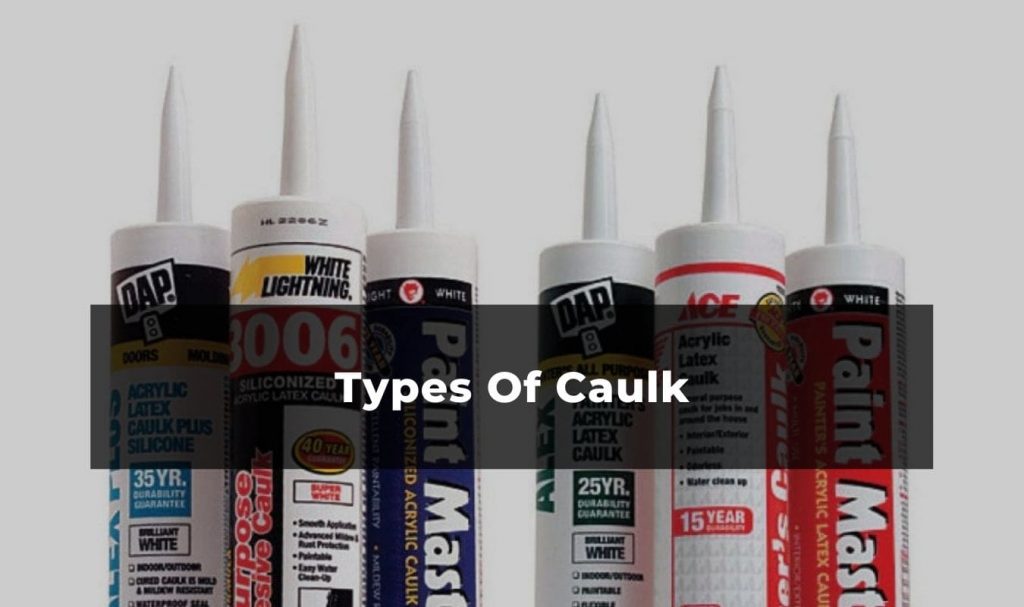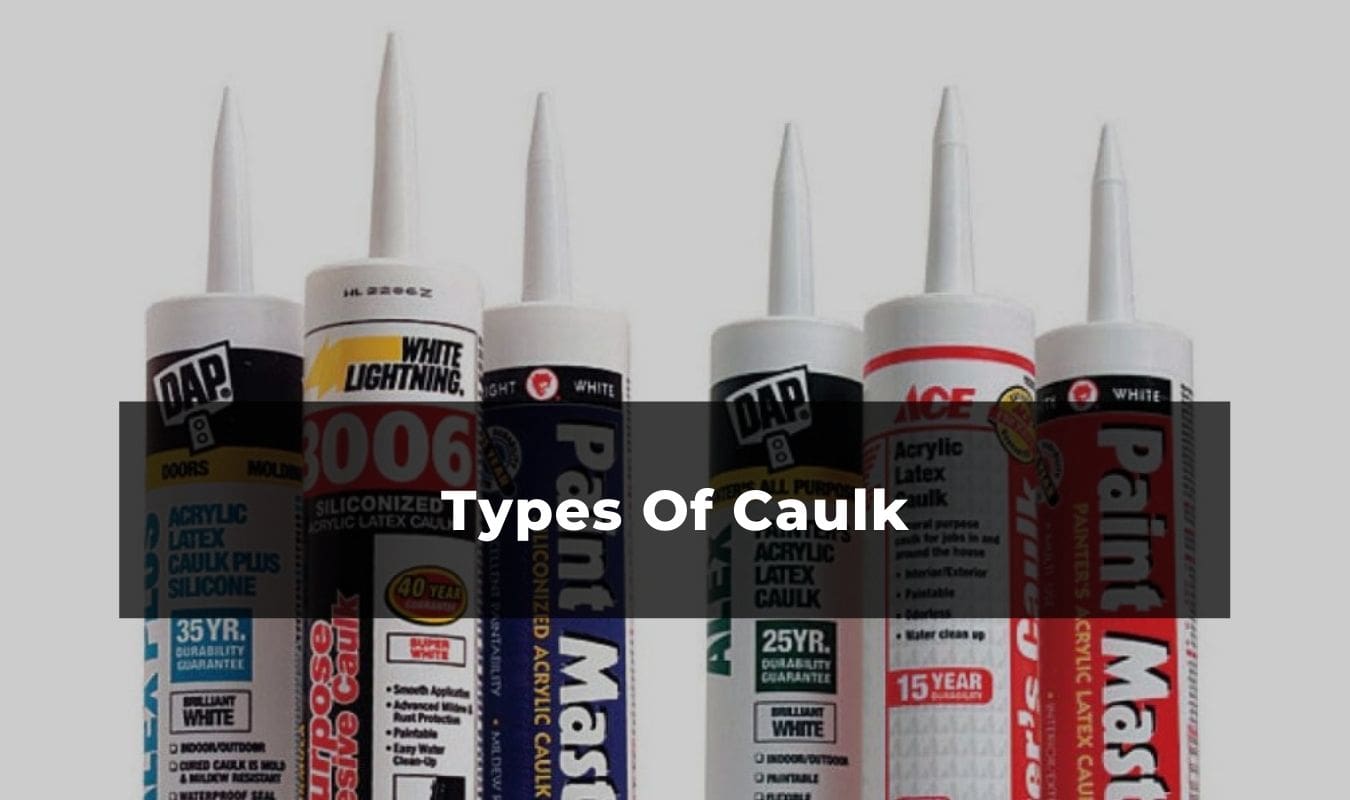
Admit it, you are one of those souls who is tired of thinking, which caulk should I use?
We understand your situation as caulks are essential building materials. They benefit commercially in fixing building leakage. If a wrong type of caulk is used the result can be costly.
There are many types of caulk in the market. They are different in adhesion, use, quality, and performance. It is hard to categorize them as they are different from each other. Yet, some say basically they are of three types.
We don’t agree with that. According to our research on the types of caulk, we have found many. They are made of different formulas, chemicals and are used for different purposes.
If you are a commercial person who deals with caulks regularly, then it is necessary for you to have a clear picture. You will get benefits from this for sure.
The Basic Types Of Caulk Based On Formulas:
The specialty of a caulk depends on the formula they are made of. There are some caulks that are best for outside applications. On the other hand, there are some caulks which can’t withstand heat or rain. The formulas are what make the differences.
We have found 4 basic formulas that are used to make caulk.
Acrylic Latex:
Acrylic latex caulks are the most common formula used in making caulks. They are easy to apply and remove. The addition of silicone with acrylic latex increases adhesion and flexibility.
Polyurethane:
Polyurethane caulks give you strong adhesion while working. They are comparatively stronger than the other formulas. You can use them to fix the cracks in rough used areas, such as your driveway.
They are super sticky and this sometimes makes it hard to work with them. The Polyurethane caulks take some time to dry. So, before painting it will be clever to wait for them to dry.
Solvent based:
The solvent-based caulks are the ones which are suitable for wet surfaces. They can withstand sunlight and don’t degrade in contact. The super gooey formula makes it hard to work with them too. They stick here and there even with your hand. So, wear gloves and be careful of not making a mess.
Hybrid:
Hybrid formulas are the combination of one or two formulas. Basically, the most common mixup is of silicone and polyurethane. This formula makes the caulks flexible and long-lasting. They are easy to apply and remove.
Check the label of your tube and you will find the manufacturers mentioning the formula on it. Knowing the basic formula of a caulk helps you understand a lot about the caulk.
Types Of Caulk:
The formulas mentioned above make various types of caulks. The formulas decide the basic features of the caulks but there are some better ones as well.
Latex Caulk:
Latex caulks are renowned for their flexibility. You can apply them on almost any surface you are working on.
The caulks are limited to extreme temperatures. This is why it will be smart not to use them where there is exposure to sunlight or heat. Use them on the inside surface for long-lasting performance.
Acrylic Latex Or The Painters Caulk:
Acrylic latex caulks aka painter’s caulks are the most user-friendly caulk in the market. The caulks feature easy application and removal. You can swipe them off with water and soap.
They come in so many colors. If you are lucky you will find the one matching the color of your surface. Otherwise, you can paint on them after one hour of application.
The caulks are durable and for interior uses only. The acrylic latex caulks are meant to cover up the small holes and then painted over. You can use them to fix the holes in your wooden windows and doors. You can use them on drywall and masonry as well.
Don’t expect watertight sealing from them.
Vinyl Latex:
Vinyl latex caulks work the same as acrylic latex ones. They are even more durable than acrylic. The application and removal feature of both is the same.
The difference among them is that acrylic caulks are soft and soluble to water. On the other hand, vinyl latex caulks are tougher and waterproof. This makes them suitable for outdoor use.
If you use vinyl latex caulks, you will find great adhesion and hold. The caulks are not flexible. This is why the experts suggest not to use them on the surface that expands or contracts.
Being waterproof the caulks are mold and mildew resistant. This is why any sort of outdoor application is recommended.
Acrylic tile sealant:
This type of caulks are meant to patch the holes and gaps between your tile areas that are vulnerable to mold and mildew. They come in small tubes.
They are not primary sealants. It is to be remembered very well. They are used as a secondary caulk that is used in between of a strong caulk. Their strong adhesion strongly holds your tiles and the primarily applied caulks together.
Siliconized acrylic Caulk:
Siliconized acrylic caulks are hybrid caulks to be more exact. The caulks combine the easy application of acrylic with the durability of silicon.
This combination makes them more durable and waterproof. As a result, you are provided with a water-tight seal. Don’t worry about the cleaning as they are more easily cleanable than pure acrylic caulks.
You can use the caulks to seal your shower, bathtub, sink, etc. Still, they are not the best caulk for outdoor applications.
Pure silicone caulks:
100 percent pure siliconized caulks are the most durable and tight ones amongst all caulks that are made. Their texture is rubbery and they are clear in color. They are waterproof and capable of sealing the same.
The silicon-based caulks provide you with a great adhesion on non-porous surfaces. The outstanding adhesion ensures longevity on your bathroom, sinks, and toilets. You can also use them on metal, glass, tiles, etc.
Still, there are limitations to these caulks. you can’t use them for all of your caulking needs. They don’t adhere to porous surfaces such as wood, masonry, drywalls.
Another important drawback of these caulks is that you can’t paint on them. So, don’t use them if you want to paint over.
Adhesive caulk:
Adhesive caulk aka liquid nails is useful where there is a need for adhesion. They are gluey and extremely strong. The caulks hold two surfaces together and also seal the joint.
The caulks are resistant to mold and mildew. They are easy to apply but hard to clean. This can be a problem if there is a need for reapplication.
Butyl Rubber Sealants:
The butyl rubber sealants are the most durable and sturdy ones. They are water-tight and flexible as well. Being so they can be used in both indoor and outdoor surfaces. These caulks can withstand extreme heat and temperature. This is why you can use them in chimneys as well. Not only that, but they can be also used in gutters, round metals, and masonry.
Butyl rubber seals up water without any difficulty. This is why they are used for roofing. They last for years without any maintenance. Even if maintenance is required, they are relatively easy to clean. On the other hand, the application of these caulks can get messy.
Fireproof caulk:
From the title, I am sure you have already guessed it.
These caulks are used generally for preventing fire movements. They are generally used to fill up insulator sealing holes where plumbing or electrical lines are used. The caulks do not catch fire and as a result, it ensures safety where there is a possibility of catching fire.
Latex silicone caulk:
Keeping in mind the limitations of the silicone caulks, a combination of both latex and silicone caulks has been made.
The manufacturer has come up with this siliconized latex solution which can be both painted and used outdoors. Besides, this caulk can also be applied to bricks and stones. It doesn’t matter whatever the weather condition is, the extreme durability of the formula makes it survive all conditions.
Asphalt:
Asphalt caulks have the same features as the butyl ones. They have the same smell, look, and stickiness as the butyl caulks. The one difference the asphalt caulks have is that they can not withstand sunlight. They start degrading if contacted to heat. This is why they are generally used to seal the ceilings or roof areas where sunlight can not reach.
Mortar repair:
Looking for a concrete performance?
These caulks are for concrete which is packed in a tube. If it is cold it gets tough to work with these caulks. Otherwise, it remains flexible and works well for sealing cracks and gaps in concrete, brick, and stones.
Polyurethane foam caulk:
Polyurethane foam caulks are generally used to seal electrical wires, and gaps, around the insulation of a building. They can be directly used in contact with the electrical wires. The sealants are flexible. They are easy to apply and harden quickly. They can be painted over as well.
Modified silicone polymers:
planning to work on vinyl, aluminum, cement, and fiber cement?
Then modified silicone polymers are exactly what you need. This caulk has all the manufacturing components of silicone, polyurethane, and water-based caulks.
The caulks are flexible and can be applied easily to water surfaces. If your metal comes in contact with water, that is not a problem either. They can be also painted on with latex paints.
Frequently Asked Questions:
What is the easiest caulk to use?
Ans: Acrylic latex caulks are the easiest to use. They are easy to apply and smooth out. Not only that, they can be easily washed out by water and soap as well. Read the label if your tube has written “siliconized” or ‘plus silicone’ on it. Silicone improves the adhesion and flexibility of your caulk.
What kind of caulk is completely waterproof?
Ans: Latex, pure silicone, and siliconized caulks are completely waterproof. They take at least 24 hours to cure and be waterproof. There are fast-drying formulas too. Their curing time depends on the temperature and humidity. Read the tube carefully and look for the mentioned formulas if you want a watertight sealing.
What type of caulk stays flexible?
Ans: Acrylic caulk is the most flexible one. They maintain that flexibility for a long period after application.
What is the best caulk?
Ans: It is difficult to say which caulk is the best. It varies depending on your requirements. Such acrylic latex caulks are best flexible caulks, the siliconized latex caulks are made for showers or bath tubs. There are caulks for tile fittings as well. Moreover, a specific type of caulk is best for a specific job. Now, it is upto you to decide the best caulk for you.
Pro tip:
Generally, all the caulks in the market come in small or medium-sized tubes. Applying directly from them can turn into a mess. It also affects the application if you are not a pro. For a proper and satisfactory application try using a caulk gun. There are so many in the market from different manufacturers at a reasonable price.
Conclusion:
Having a clear picture of the type of caulks can be beneficial information for any builder. Choosing the right caulk for the job results in satisfactory customer feedback. So, if you are a professional, it is a must that you use the accurate caulk depending on the exposure, surface type, and adhesion needed. Otherwise, it will be harmful for your reputation.

